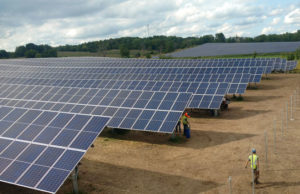by Dennis Dalman
news@thenewsleaders.com
The city of Sartell will save an estimated $651,000 on its electric bill over a 25-year period because of a solar-energy subscription agreement the city council approved unanimously at its last meeting.
During that 25-year period, the city will pay an accumulated total of $2.137 million for the subscription. That amount, minus the estimated $2.788 million in energy costs equals the savings to the city.
The subscription agreement with New Energy Equity is for the purchase of 700,000 kilowatt hours of electricity, about 40 percent of that the city currently uses, about 180,000 kilowatt hours per year. Sartell had the option of subscribing to anywhere from 100,000 to the full 180,000 kilowatt hours, but the council decided to go with 40 percent of the total just to be on the safe side since it’s a new venture.
A kilowatt hour is a measure of electrical energy equivalent to a continuous power consumption of 1,000 watts for one hour.
The solar energy for the Sartell subscription will be generated by a “solar garden” in the Melrose area. For about two years, the Sartell City Council had planned on solar generation from a solar farm to be installed near Heritage Drive, an agreement made with a firm called SolarStone. That arrangement, however, fell through because of a complicated maze of difficulties involving permit processes and such. Thus, the council had to go back to the drawing board with other options.
Many other cities have opted for solar-energy subscriptions, not only to save on electricity costs but to help protect the environment from emissions of carbon-based fuels, such as coal-fired electric plants.
What’s a solar garden?
Solar gardens are solar photovotaix systems that produce electricity for participating subscribers, a way for Minnesotans to benefit from solar power without having to install their own stand-alone project.
Many, including cities, can subscribe to solar projects owned by their utility providers. Customers served by Xcel Energy, such as the City of Sartell, can subscribe to privately owned solar-generated projects, such as the one in the Melrose area in the Sartell agreement.
Residents in central Minnesota have become increasingly aware of “solar gardens” (or “solar farms”) on the landscape. Large areas of solar panels installed in long rows to soak up the sun’s energy and convert it through photovoltaic cells into electricity. Just east of the Evergreen Village mobile-home park in east Sartell is a recently installed solar garden that provides a certain amount of electricity to LeSauk Township and to Sauk Rapids.
Other energy options
At its last meeting, besides approving a solar subscription, the council members also made a few decisions about other energy-saving options for the city that had been under consideration during the past year.
At the last council meeting, two officials from Apex Clean Energy (headquartered in Charlottesville, Virginia) were present to answer any questions.
The council did agree unanimously to retrofit all the city-owned street lights with LED bulbs. There are close to 500 light poles in the city, including at city hall and at the Bernick’s Arena area, that will be retrofitted. The energy savings for doing so would be about $14,000 annually, guaranteed. LED street-lamp bulbs have a life expectancy of from 10 to 15 years and possibly up to even 20 years, an Apex official noted.
About half of the city light poles will be replaced as they are in rather shabby condition.
The council decided to skip any solar-garden projects for the city for the time being, even though they are open to them in the future as technology becomes even better. A solar garden on the roof of the new high school has been considered, the council learned, but it is not yet a definite “go.” Structural analysis of the school must be completed first, said an Apex official.
Other energy-saving projects that have been discussed at previous council meetings will remain options for the council, but they will be considered in upcoming meetings one by one.
Such projects include water-saving options, such as putting energy “envelopes” around public buildings (ways to seal cracks against heat loss); and replacement of all old-fashioned water meters in the city with ones that are so high-tech they emit radio waves that provide an astounding amount of data about water usage at each meter place. Those and other energy- and water-saving options will be discussed at council meetings during the rest of this year and beyond.

This is a typical solar garden, one of many being assembled throughout Minnesota. This particular one is near St. Joseph.



